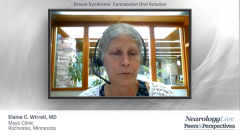
Presentation of Dravet Syndrome
Joseph Sullivan, MD, and Elaine C. Wirrell, MD, discuss the presentation of Dravet syndrome in children.
Episodes in this series

Joseph Sullivan, MD: Hello, and thank you for joining this Neurology Live® Peers & Perspectives® presentation titled “Comprehensive Management of Dravet Syndrome.” Today we’re going to discuss the diagnosis, management, and treatment of Dravet syndrome. My name is Dr Joseph Sullivan, and I’m a professor of neurology and pediatrics at the University of California San Francisco, where I direct the Pediatric Epilepsy Center at the Benioff Children’s Hospitals. Joining me is Dr Elaine Wirrell, director of pediatric epilepsy at Mayo Clinic in Rochester, Minnesota. Thank you so much for joining us, Elaine. Let’s begin.
Elaine C. Wirrell, MD: Nice to see you.
Joseph Sullivan, MD: Hopefully we can see each other in person soon, but for this discussion, we can still have it in a meaningful way. We’re here to talk about Dravet syndrome, which I know is near and dear to both of us, because we have taken care of many families and have been involved in writing papers together and collaborating on research trials. But for those who are maybe coming across this diagnosis as a patient or a family for the first time, or maybe as a neurology provider who’s taking care of their first patient with Dravet syndrome, maybe we could start by discussing what we feel is the classical presentation of these children and why it’s so important to recognize that presentation. Would you like to start us there?
Elaine C. Wirrell, MD: Sure, I’d love to. The classic presentation of Dravet syndrome is an otherwise previously healthy, developmentally normal child. There are no other risk factors that we know of for seizures like a perinatal insult or anything like that, and typically the first year of life and often around 6 or 7 months is when these kids have their first seizure. They present first with an often prolonged and often hemiconvulsive seizure, which is very frequently associated with fever, often a low-grade fever. About a quarter of them can actually present following their immunization when they develop fever, and then they have recurrent prolonged and often hemiconvulsive seizures. After the first year of life, maybe in the second or third year of life, they typically develop other seizure types, like myoclonic or absence seizures or focal-impaired awareness seizures. At that point we start to see the child whose development was normal but then starts to fall off. They’re not gaining those milestones as quickly as we had hoped. That’s the characteristic presenting symptom, and there’s really no other underlying cause that people can find unless you do the genetic testing. The MRIs are normal. Oftentimes the EEGs [electroencephalograms], if you do them remote from seizures, are also normal.
Joseph Sullivan, MD: I couldn’t agree more. When I think about this back to my general pediatrics training on febrile seizures, in some ways this has been a little bit of a barrier to suspecting this diagnosis. We’re just ingrained—febrile seizures are common. If you have a 6- month-old who comes in, they have their vaccine, they have a fever—as you said, it’s low grade, but ER [emergency department] physicians, and pediatricians are like, it’s “just a febrile seizure.” I’m sure many of our families have heard that. But what we’ve seen over time, and some studies to support it, is that having a febrile seizure—especially prolonged—at 6 months is already a bit of a red flag.
Elaine C. Wirrell, MD: I agree.
Joseph Sullivan, MD: Red flags should go up, and I certainly wouldn’t have the confidence to make that diagnosis after a first seizure, but already in 2021 I’m starting to think about that. Hopefully a lot of people watching this have heard of Dravet syndrome. It’s rare, but it’s not so rare. There have been a couple of studies done. I was part of 1 that looked at an electronic medical record system to see how many patients were presenting with their first seizure and continued on seizure medicine, to try to see—if we cast a really wide net—how many of those patients present in the way you mentioned and then go on to have that subsequent evolution for Dravet? What we found is that it’s about 1 in 15,700, so that equates to between 250 and 350 new diagnoses per year, which is rare but not so rare. If you’re a busy community child neurologist, you very well are going to have a patient like this in your practice.
Elaine C. Wirrell, MD: Absolutely.
Joseph Sullivan, MD: Thank you for watching this Neurology Live® Peers & Perspectives®. If you enjoyed the content, please subscribe to our e-newsletters to receive upcoming programs and other great content in your in-box. Thank you so much.
Transcript Edited for Clarity
Newsletter
Keep your finger on the pulse of neurology—subscribe to NeurologyLive for expert interviews, new data, and breakthrough treatment updates.






































